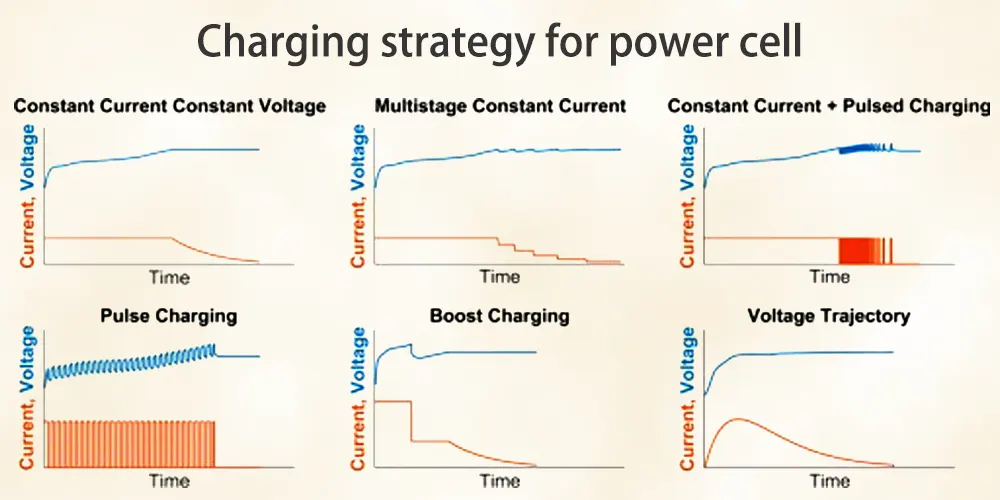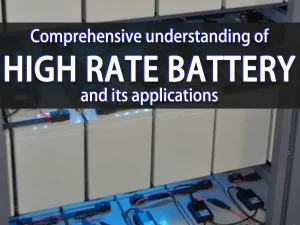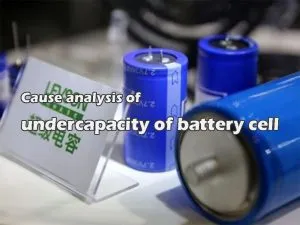What is power cell and power cell design strategy analysis

In the design of power cell, at least two aspects of polarization and temperature rise need to be considered. Usually, power cell can be optimized and improved through four aspects: material selection, structural design, process design and charging strategy, so as to design a lithium battery that can meet fast charging and discharging.
Power cell materials selection
Cathode material
When a lithium battery is charged and discharged with a high current, Li+ is quickly deintercalated in the active material. For the cathode materials in power cell, the O2- in the one-dimensional olivine structure lithium iron phosphate forms close packing around Li+, which greatly affects the diffusion performance of Li+.
The two-dimensional layered structure of lithium cobalt oxide and the ternary material of the ternary lithium battery allow Li+ to be intercalated between layers, while the three-dimensional spinel structure of lithium manganate is most suitable for the rapid deintercalation of Li+.
From the perspective of the ease of diffusion, the ranking of the most suitable cathode materials for the preparation of power cell is: spinel lithium manganese oxide > lithium cobalt oxide > ternary materials > lithium iron phosphate.
Anode material
For anode materials in power cell, graphite has high conductivity and low and stable lithium intercalation potential, and is currently the mainstream anode material. However, the layered structure of graphite makes it highly anisotropic, Li+ can only be embedded from the end face of graphite, and then diffuse into the interior of the particle, increasing the diffusion path, resulting in poor rate performance of graphite.
Amorphous soft carbon or hard carbon has a larger interlayer spacing and a more complex staggered structure, which increases the channels for Li+ deintercalation and increases the diffusion rate of Li+. MCMB prepared from mesophase pitch, one of the soft carbon materials, has a spherical structure that allows Li+ to be embedded and extracted from all directions on the spherical surface, and is one of the preferred anode materials for power cell.
Power cell separator selection
Lithium battery separators of the power cell mainly include: polyolefin microporous membranes, non-woven fiber separators, inorganic composite membranes, and gel polymer electrolyte membranes. Due to the characteristics of easy-to-obtain raw materials, good mechanical strength and chemical stability, polyolefin separators are currently the most commonly used separators for lithium batteries.
Generally, the separator has a porous structure and is arranged between adjacent cathode and anode, which is an electronic insulator, but allows Li+ to freely shuttle between the pores. The separator has the characteristics of electronic insulation and ion conduction.
Usually, Li+ can pass through the separator quickly by reducing the migration path, increasing the pore size and porosity of the separator, and realizing the rapid charge and discharge of the lithium battery.
Power cell electrolyte selection
Conventional liquid electrolyte consists of three parts: lithium salt, solvent, and additives. Among them, the lithium salt is used to provide active Li+, and the solvent is used to dissolve the lithium salt. There are many kinds of additives, including film-forming additives, overcharge additives, flame retardant additives, etc., which usually have a certain functional effect.
LiPF6 is easy to dissociate, has a high lithium-ion migration number, good oxidation resistance and good aluminum foil passivation ability, etc., and has become the most commonly used lithium salt in lithium battery electrolyte. But its shortcomings are also obvious, such as poor thermal stability, easy hydrolysis, and raw materials need to be stored in a low-temperature and anhydrous environment.
Therefore, the lithium salt concentration, solvent composition, and additives of the electrolyte will affect the intrinsic characteristics of the electrolyte, which in turn will affect the performance of the power cell of the lithium battery.
Structural design of power cell
Tab size
When a lithium battery is charged and discharged at a high rate, due to the large current, the temperature rise at the tab position is large, which in turn leads to an overheating of the entire battery, a decrease in battery performance, and an increase in safety risks.
Generally, the current allowed to pass through the tab is positively related to the cross-sectional area of the tab, that is, the larger the cross-sectional area of the tab, the greater the current allowed to pass. Reasonable tab design is an important factor in the design of power cell.
Tab position
The position of the tab will affect the internal resistance and temperature distribution of the battery, which in turn will affect the battery rate performance and cycle performance.
When the tab welding position is in the middle of the current collector, the internal resistance is the smallest. When the tab is welded at the end of the current collector, its internal resistance is 4 times that of welding in the middle. When the tabs are welded at the end, the DCR and EIS impedance of the full battery are larger, which is not conducive to the rapid charging and discharging of power cell of lithium battery.
Number of tabs
The number of tabs has an important impact on the performance of the power cell of the lithium battery. The larger the number of tabs, the smaller the internal resistance, the smaller the polarization and heat generation, and it is more suitable for high-rate charging and discharging. For example, electric vehicles and drones with high power requirements all use power cell with multi-pole structure.
Process design of power cell
Proportion of electrode conductor
A small amount of conductive agent is usually added to the cathode and anode formulations to collect micro-current between the active material and the current collector, so as to reduce the contact resistance of the electrode, accelerate the movement of electrons, and improve the electronic conductivity of the electrode.
Theoretically, the more the conductive agent content, the higher the conductivity of the pole piece and the smaller the internal resistance of the battery. However, in fact, too much conductive agent is prone to agglomeration, which blocks the electrical connection between active particles and leads to poor rate performance.
Areal density
The smaller the areal density, the thinner the electrode, the shorter the Li+ diffusion distance, which reduces the Li+ migration path, which can greatly reduce the concentration polarization. Comparing the EIS impedance of lithium cobalt oxide surface densities of 150g/m2, 180g/m2, and 220g/m2 respectively, it is found that as the surface density increases, the total EIS impedance gradually increases, that is, the resistance of Li+ during the electrochemical reaction becomes larger .
In addition, as the areal density increases, the slope of the straight line in the low-frequency region deviates from the 45° angle, indicating that the diffusion rate of Li+ in the electrode becomes slower.
Compaction density
Under the same areal density, different compaction designs will also affect the performance and cycle performance of lithium battery power cell. The lower the compaction density, the larger the porosity of the electrode, the smaller the diffusion resistance of Li+ in the active material, and the faster the diffusion speed.
However, if the compaction density is too low, it may lead to poor contact between particles, a decrease in electronic conductivity, and an increase in the polarization of electrochemical reactions.
Formation process of power cell
Formation is one of the essential processes in the manufacturing process of lithium-ion batteries. In this process, the solvent or film-forming additive is reduced on the surface of the anode to form an SEI film with a thickness of about 100–120 nm to prevent further side reactions of the solvent, thereby reducing the loss of active lithium. After a lot of research, it has been shown that the SEI film has a significant impact on the performance of power cell.
From the perspective of EIS impedance, the SEI film formed by using shorter charging time and larger current has smaller impedance, which seems to have better fast charging performance for power cell.
However, in fact, the fast charging performance of power cell is not only related to the impedance of the SEI film itself, but also related to the stability of the formed SEI film. The low-resistance SEI film formed in the formation stage is of little significance if the stability of the SEI film during long-term cycling cannot be maintained.
Charging strategy for power cell
The main reason why lithium batteries are charged with constant current and constant voltage is to eliminate the polarization of the battery during using battery charger to charge. That is, the voltage monitored during charging and discharging is not the actual voltage of the battery, unless the current is very small, but charging with a small current will make the charging speed very slow and the charging time will be greatly extended.
Therefore, constant current and constant voltage charging is currently the most efficient charging method, and at the same time causes less damage to the battery.
The essence of high voltage overcharge is constant current and constant voltage charging. High-voltage overcharge technology refers to increasing the charging cut-off voltage and increasing the charging cut-off current, so as to achieve the same charging capacity and greatly reduce the charging time. High-voltage overcharge technology is very effective in reducing the charging time of power cell.
The charging speed of lithium battery power cell can be improved by adopting the step charging method. That is, high current charging is used in the low SOC range, and low current charging is used in the high SOC range. By increasing the average charging current, the charging time is reduced without significantly affecting the battery life.
The method of charging a lithium battery in a short period of time with a certain constant current is called pulse charging. The charging capacity and intermittent time can be controlled by pulse current and pulse duty cycle, thereby effectively eliminating charging polarization and realizing fast charging of lithium battery power cell.
Taking the commercialized 18650 battery as an example, different pulse magnifications, pulse times and resting times were designed respectively, and it was found that:
● The positive pulse time has no obvious effect on the charging capacity and maximum temperature, but it can reduce the charging time;
● The standing time has no obvious effect on the charging capacity and maximum temperature, but it will prolong the charging time;
● After increasing the pulse magnification, the charging capacity becomes smaller, the charging time is greatly reduced, and the maximum temperature is higher.






























